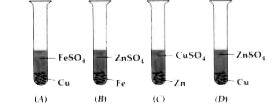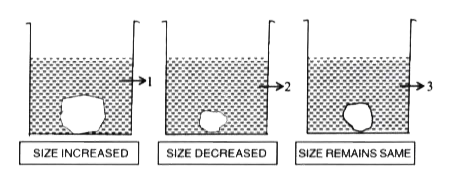Sheela designs an experiment to test the effect of solute concentration during osmosis. She takes four equal sized potato cubes having an identical weight and places each cube in four separate test tubes I, II, III, and IV, containing 1%, 2%, 3%, and 4% sucrose concentrations respectively. After one hour, she removes the cubes from the test tubes, blots the pieces with a paper towel, and weighs them to find the final mass of each cube. The solution in test tube Ill was hypertonic to the cytoplasm of the potato cells. What change will be observed in the potato cube of test tube Ill?
The final weight of the potato cube will be less than its initial weight.
The final weight of the potato cube will be more than its initial weight.
There will be equal movement of water in and out of the potato cube.
There will be equal movement of sucrose in and out of the potato cube.
The correct Answer is:A
Similar Questions
A student took four test tubes I, II, III and IV containing aluminium sulphate, copper sulphate, ferrous sulphate and zinc sulphate solutions, respectively. He placed an iron strip in each of them. In which test tube, a brown deposit is formed?
View SolutionA student took four test tubes I, II, III and IV containing aluminium sulphate, copper sulphate, ferrous sulphate and zinc sulphate solutions, respectively. He placed an iron strip in each of them. In which test tube, a brown deposit is formed?
View Solution
Knowledge Check
A student took four test tubes I,II,III and IV containing aluminium sulphate, copper sulphate, ferrous sulphate and zinc sulphate solutions respectively. He placed iron strips in each one of them. after some time he found a brown deposite formed in test -tube marked:
 AIBIICIIIDIV
AIBIICIIIDIVThe test tube I contains sodium bicarbonate solution whereas test tube II contains lemon juice. On introducing pH paper strips in both the solutions, it is observed that the pH paper turns:
Ared in I and blue inIIBblue in bothCblue in I and red in IIDred in I and pink in II
You have been provided with three test tubes. One of them contains distilled water and the other two contain an acidic solution and a basic solution, respectively. If you are given only red litmus paper, how will you identify the contents of each test tube?
View SolutionYou have been provided with three test tubes. One of them contains distilled water and the other two contain an acidic solution and a basic solution respectively. If you are given only red litmus paper, how will you identify the contents of each test tube ?
View SolutionFour test tubes were taken and marked A, B, C and D respectively. 2 mL of solution of Al2(SO)3 in water was filled in each of the four test-tubes. Clean piece of metal zinc was placed in test tube A, clean iron nail was put in test tube B, clean copper wire was placed in test tube C and a clean aluminium wire was placed in test tube D. What colour change would you observe in all the four tubes ?
View SolutionIn the following four test tubes, some metals are in contact with certain salt solutions. After the experiment, in which of the test tubes does the solution becomes colourless and a powdery red mass is deposited at the bottom of the test tube ?

View SolutionYou have been provided with three test tubes. One of them contains distilled water and the other two contain an acidic solution and a basic solution, respectively. If you are given only red litmus paper, how will you identify the contents of each test tube?
View SolutionA candidate in order to study the process of osmosis has taken 3 potato cubes and put them in 3 different beakers containing 3 different solutions. After 24 hours, in the first beaker, the potato cube increased in size, in the second beaker, the potato cube decreased in size and in the third beaker there was no change in the size of the potato cube. The following diagram shows the result of the same experiment :

In beaker 3, the size of the potato cube remains the same. Explain the reason in brief.
View Solution
